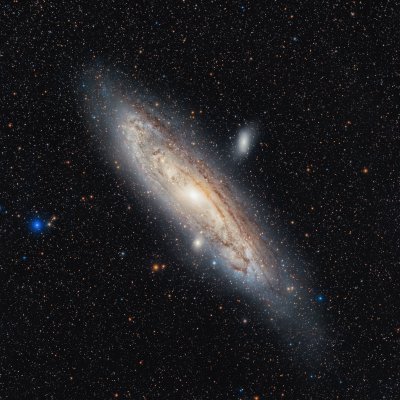|
Universe is often considered to be just black and white when
observed by naked eye or small telescope. That's because our eyes do
not distinguish colors when the light intensity is very low and with
the exception of bright planets (Mars is reddish, Jupiter and Saturn
color is yellow-brown) and stars (for instance Antares looks also
somewhat reddish), all star clusters, nebulae and galaxies appear
monochrome (maybe it is possible to distinguish magenta hues in the
Great Orion Nebula when observed through a telescope, because it is
really bright). Long exposure CCD photography can reveal colors of all
deep-sky objects and galaxies or planets are often displayed in real
colors (well, often enhanced to increase image impact).

Wide field image of the M31 Great Andromeda Galaxy shows
real colors Images of nebulae are sometimes displayed in false colors. This is
because emission nebulae shine mainly in three narrow spectral lines,
depending on their chemical composition, as opposed to light of stars
(and thus whole galaxies), which spectrum is continuous (with the
exception of some absorption lines, of course). These lines are named
according to the chemical elements, which are responsible for the
emission—Hα, OIII and SII. While OIII
line is close to the green-blue color, Hα line is so deep red,
that it is hard to see by many people and SII line is even redder than
Hα, practically invisible for humans. This is why astronomers
assign false colors to narrow-band images to show details, which would
otherwise remain hidden to us. And we must understand, that what is in
reality deep-red, is displayed as green-blue on narrow-band
images.
The “North America” and “Pelican” nebulae in
real colors (left) and in false colors (right) The real difference between emission nebula real colors and
false-colored narrow-band image is exceptionally well illustrated by
the images of the North America and Pelican nebulae above. Both images
were combined from individual exposures acquired through red, green,
blue and narrow-band filters, acquired with the same telescope and
camera.
All images on this page courtesy of Philippe Bernhard. Images were
acquired with G4-16000 CCD camera on RH200 telescope.
| 